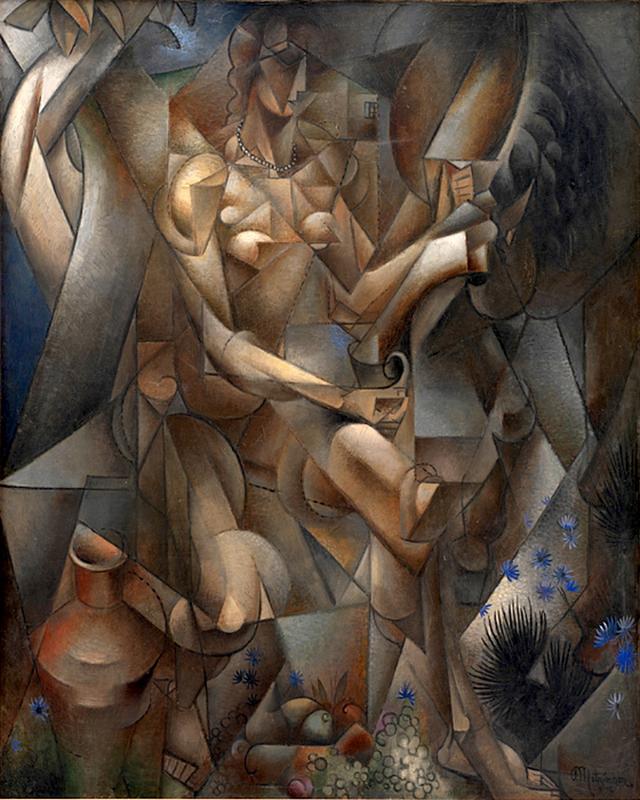More about Woman with Horse

Contributor
The art world has a long history of people working to censor art in the name of decency.
Whether it's the Spanish Inquisition confiscating The Nude Maja in 1815, or a senator calling Robert Mapplethorpe’s The Perfect Moment morally repugnant in 1989. These people have always believed themselves to be the last line of defense between hedonistic artists and a moral citizenry. What they don’t realize is that as much as they care about censoring pornography, artists care even more. Remember artists, while willing to take risks, want to be labeled as artists, not pornographers. There is a very particular difference between The Birth of Venus, and The Dream of Fisherman’s Wife. Even though they both involve naked women presented in relation to sea creatures, only one is meant to be used as masturbation material. And it's that thin, nearly invisible line that Jean Metzinger is attempting to explore here, and he is doing so in a very revolutionary way.
Prior to the 20th century, and basically all the way back to the Renaissance, the nude human form has been a focus of the art world. However, even artists acknowledge that you can’t just go around painting naked people and calling it a day. The solution was to paint or sculpt or illustrate a naked person, and then say that the subject is actually some famous figure from history or folklore. It sounds cheap, but it should be noted that this worked for about 200 years. However, with the coming of the modern age and its obsession with deconstruction and subversion, the mythos approach would no longer cut the mustard. As a result, artists took to stylization, sometimes painting people with their flaws exaggerated as with Egon Schiele, or as in this painting, using Cubism itself as a sort of veil.
In naming Woman with Horse, Jean magically transmutes the painting from a stylized nude into a sort of visual puzzle as it demands that we spend all of our attention trying to find the horse that critics will insist is there. Some see the woman riding atop him, side saddle, while others point out you can see the horse in the upper right corner, being caressed by the woman and eating a piece of given fruit. This idea that cubist paintings can show different scenes at once, or the same scene from a multitude of perspectives, directly influences Danish physicist Niels Bohr. Upon reading the theories of Metzinger and Albert Gleizes on analytic Cubism, in their book Du "Cubisme", Bohr had the thought that an electron is both a particle and a wave, but it will always be measured to be either one or the other. Just like an abstract painting, however you view it, is the way it is.
Sources
- Borzello, Frances “Nude Awakening” The Guardian 11/02/2002 https://www.theguardian.com/artanddesign/2002/nov/02/art.artsfeatures
- Sorabella, Jean “The Nude in Baroque and Later Art” The Met, January 2008 https://www.metmuseum.org/toah/hd/nuba/hd_nuba.htm
- Wolfe, Shira “10 Controversial Art Pieces That Shook the Art World” Artland viewed on 05/27/2020 https://magazine.artland.com/controversial-artwork-shook-the-world/
- Web Contributor “Artworks and Artists of Salon Cubism” The Art Story viewed on 05/27/2020 https://www.theartstory.org/movement/salon-cubism/artworks/
- Web Contributor “Naked Truth: Approaches to the Body in Early-Twentieth-Century German and Austrian Art” Middlebury College Museum of Art viewed on 05/27/2020 http://museum.middlebury.edu/exhibitions/past/2015-2016/node/1455
- Miller, A. From issue 2523 of New Scientist magazine, 29 October 2005, page 44
Featured Content
Here is what Wikipedia says about Woman with a Horse
Woman with a Horse (French: La Femme au Cheval, also known as L'Écuyère and Kvinde med hest) is a large oil painting created toward the end of 1911, early 1912, by the French artist Jean Metzinger (1883–1956). The work was exhibited in Paris at the Salon des Indépendants (20 March–16 May) in 1912 and the Salon de la Section d'Or, 1912. The following year La Femme au Cheval was reproduced in The Cubist Painters, Aesthetic Meditations by Guillaume Apollinaire (1913).
The artist has broken down the picture plane into facets, presenting multiple aspects of the subject in succession and/or simultaneously. This concept first pronounced by Metzinger in 1910—since considered a founding principle of Cubism—would soon find its way into the foundations of the Copenhagen interpretation of quantum mechanics; the fact that a complete description of one and the same subject may require diverse points of view which defy a unique description. The painting was owned by the poet Joseph Houot (known as Jacques Nayral). In 1918 La Femme au Cheval was exhibited at International Kunst, Kleis Kunsthandel, Copenhagen, an exhibition arranged by Herwarth Walden.
It was presumably bought by a Danish collector in 1918. The painting was subsequently sold at auction through art dealer Kai Grunth hos Winkel & Magnussen, auction no. 108, February 19, 1932, lot no. 119. Purchased by Danish physicist Niels Bohr. After his death Woman with Horse was sold by his widow Margrethe Bohr (through Ernest Bohr) to the Statens Museum for Kunst in Copenhagen. It is now in the Royal Collection of Paintings and Sculpture at the museum.
Check out the full Wikipedia article about Woman with a Horse












